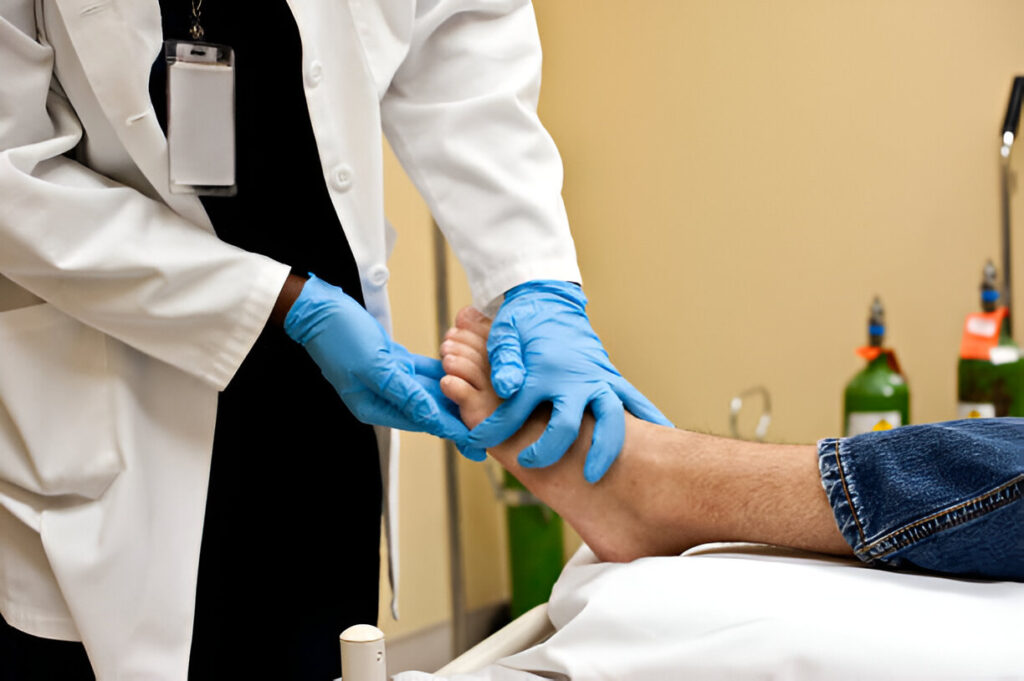Foot problems and related concerns are common for people who have diabetes. One of the most concerning issues is Charcot’s foot. This disorder causes the soft tissues, joints, and bones in your foot or ankle to deteriorate. Due to this breakage, the shape of your feet changes and gets weakened. This also makes your foot so unstable that you might face difficulty while walking, and you might be more prone to foot ulcers and fungal infections. In the rare case scenario, you might have permanent foot deformities and might end up with amputation.
But while talking about the negative sides, with proper care and attention, you might easily stay away from this condition, or you can save your feet with charcot foot management. Let us see about those in detail in the upcoming sessions.
Charcot Foot: What Really Happens?
Charcot foot might possibly occur when the nerves in the foot are damaged by diabetes. The nerves in charge of controlling muscles, pain, and temperature stop working correctly. This sets off a series of events:
- The patient cannot feel pain or injuries to the foot.
- Even if bones fracture or joints dislocate, they continue walking on the foot.
- This causes repetitive microtrauma, leading to further damage.
- Blood flow changes (due to autonomic neuropathy) make the bones weaker and more prone to collapse.
- As time passes, the foot becomes unstable and malformed.
A foot that is swollen, red, and warm in the early stages and deformed with a high risk of ulcers and infections in the later stages is the end result.
Why Is It Called “Charcot”?
The French neurologist Jean-Martin Charcot was the one who initially identified this kind of joint disease. This was actually identified in syphilis patients in the 1800s and was given the name Charcot foot, after the name of the founder. Later, after a while, this issue was also noted with the diabetic patients who had nerve damage. For them, this was especially on their feet. These days, it has become more common; it is most frequently linked to chronic, poorly controlled diabetes or wrong footwear.
Who Is at Risk of Developing Charcot Foot?
Charcot arthropathy most commonly affects diabetic patients with peripheral neuropathy. However, not every diabetic patient develops Charcot. Certain risk factors increase the likelihood:
- Having diabetes for over ten years
- Poor control of blood sugar
- Previous foot trauma, injury, or ulcer
- When you have diabetic retinopathy or nephropathy
- Obesity or high body weight
- Smoking, which reduces circulation
- Foot surgeries or fractures
- Chronic kidney disease or dialysis
How to Recognize the Early Signs?
Since Charcot foot frequently resembles other foot conditions, managing it can be extremely difficult. But there are some important symptoms and indicators to look out for, particularly in people with diabetes:
- Sudden swelling in one foot
- Redness and warmth (the affected foot may feel significantly warmer than the other)
- The skin may look shiny or tight
- Minimal or no pain, despite significant damage
- A feeling of instability or “looseness” in the foot
- Difficulty fitting into regular shoes
- Popping or cracking sounds while walking
How Does Charcot Arthropathy Get Diagnosed?
Clinical Approach:
- Examine the foot for temperature differences (a temperature difference of >2°C is suspicious).
- Look for signs of neuropathy, including reduced sensation or absent reflexes.
- Remove any ulcers, infections, or open wounds.
Imaging:
- X-rays: May show no abnormalities at first, but they may later reveal deformities, fractures, joint dislocations, and bone resorption.
- MRI: Useful in identifying early changes in the bone marrow and differentiating between bone infection and Charcot.
- CT scan: Useful in complex or advanced cases to visualize joint collapse or plan for surgery.
- Bone scan or labeled WBC scan: Sometimes used to differentiate infection from Charcot changes.
Stages of Charcot Foot
Charcot arthropathy progresses in clearly defined stages. Understanding these stages helps in guiding treatment.
Stage 0 (Prodromal Stage)
- Foot is warm, swollen, and red
- X-rays are normal
- Often mistaken for cellulitis or infection
- Early offloading can prevent progression
Stage 1 (Fragmentation)
- Bone fractures and joint dislocations appear
- X-ray shows bone debris and misalignment
- Foot remains inflamed
- Crucial stage for immobilization
Stage 2 (Coalescence)
- Swelling and warmth begin to reduce
- Bones begin to heal and fuse
- Deformity becomes more visible
Stage 3 (Consolidation/Reconstruction)
- Inflammation resolved
- Foot is now deformed and rigid
- Requires long-term bracing or surgical correction
How Is Charcot Foot Treated?
For charcot foot treatment, diagnosing it early and complete offloading of the foot are the ways for successful treatment.
Non-Surgical (Conservative) Treatment:
1. Total Contact Cast (TCC)
- Gold standard treatment in early stages
- Distributes pressure evenly across the foot
- Worn for 3 to 6 months, changed every 1–2 weeks
2. Removable Cast Walkers or Boots
- Used once acute inflammation subsides
- Allows limited mobility and better hygiene
3. Custom Orthotics and Footwear
- After healing, patients need lifelong support
- Prevents further injury or ulcer formation
4. Blood Sugar Control
- Tight glycemic control prevents further nerve damage and improves healing
Surgical Treatment:
Charcot foot surgery options are considered when conservative management fails or in cases of:
- Severe deformity
- Recurrent ulcers that don’t heal
- Joint instability that prevents walking
- Infection that threatens limb viability
Common surgical procedures include:
- Bone debridement (removal of dead bone)
- Correction of deformity using osteotomy or joint fusion (arthrodesis)
- Exostectomy (removing bony prominences)
- External fixation or internal screws for alignment and stabilization
Long-Term Outlook & Management
For Charcot foot management, it is important that once you are diagnosed with Charcot foot, to avoid amputation, patients must:
- Use custom footwear at all times
- Inspect feet daily for signs of swelling, redness, or ulcers
- Avoid walking barefoot
- Maintain regular visits with a podiatrist or foot specialist
- Avoid trauma or overuse of the affected foot
Prevention Is the Best Cure
Charcot foot may be rare, but it is highly preventable. All diabetic patients—especially those with neuropathy—should follow foot care practices seriously:
- Control blood sugar
- Wear protective, cushioned footwear
- Avoid heat (hot water bottles, heating pads)
- Report any swelling, redness, or temperature change to a doctor immediately
- Get annual foot exams, even if you feel fine
Conclusion
The condition known as Charcot arthropathy is painful. You can save your feet by identifying the signs while it appears and looking for medical attention or charcot foot management immediately. If you start to notice unusual signs as discussed above, do not delay in starting the next process. Once you are aware of diabetes, it is best to speak with a diabetic foot care specialist in advance. With this action, you could discuss with the diabetes doctor and take preventive measures. Because only with proper care can deformity and amputation be avoided, and quality of life can be preserved.






